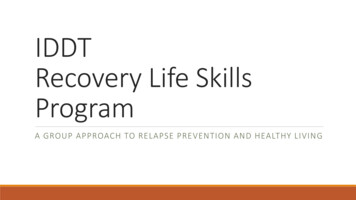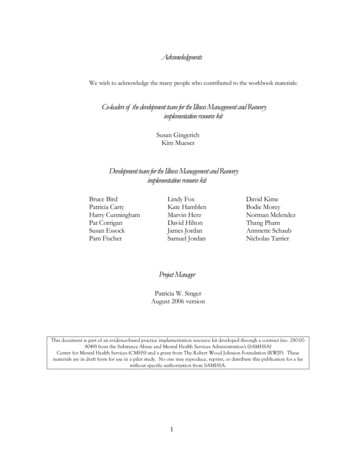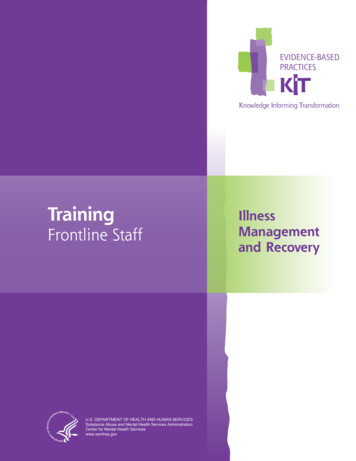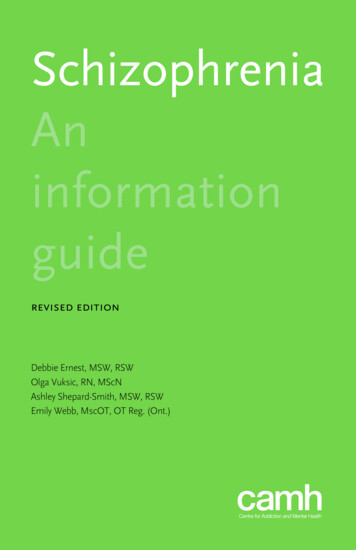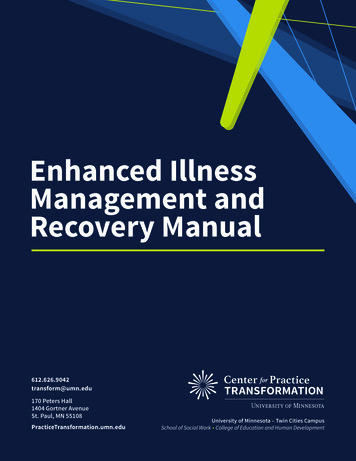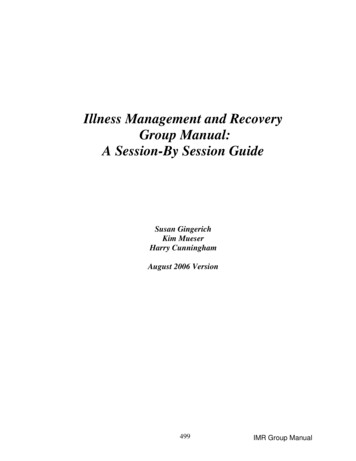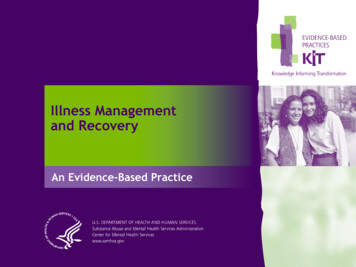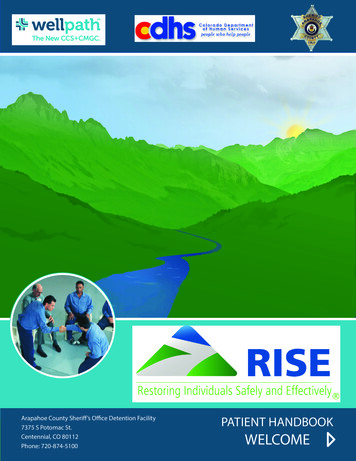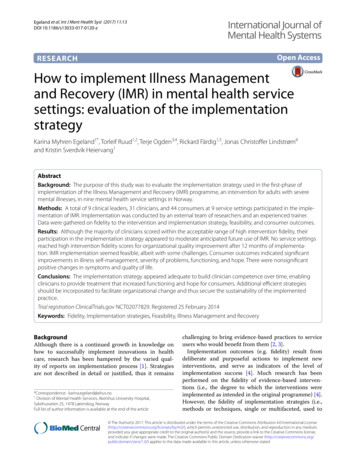
Transcription
Egeland et al. Int J Ment Health Syst (2017) 11:13DOI 10.1186/s13033-017-0120-zInternational Journal ofMental Health SystemsOpen AccessRESEARCHHow to implement Illness Managementand Recovery (IMR) in mental health servicesettings: evaluation of the implementationstrategyKarina Myhren Egeland1*, Torleif Ruud1,2, Terje Ogden3,4, Rickard Färdig1,5, Jonas Christoffer Lindstrøm6and Kristin Sverdvik Heiervang1AbstractBackground: The purpose of this study was to evaluate the implementation strategy used in the first-phase ofimplementation of the Illness Management and Recovery (IMR) programme, an intervention for adults with severemental illnesses, in nine mental health service settings in Norway.Methods: A total of 9 clinical leaders, 31 clinicians, and 44 consumers at 9 service settings participated in the implementation of IMR. Implementation was conducted by an external team of researchers and an experienced trainer.Data were gathered on fidelity to the intervention and implementation strategy, feasibility, and consumer outcomes.Results: Although the majority of clinicians scored within the acceptable range of high intervention fidelity, theirparticipation in the implementation strategy appeared to moderate anticipated future use of IMR. No service settingsreached high intervention fidelity scores for organizational quality improvement after 12 months of implementation. IMR implementation seemed feasible, albeit with some challenges. Consumer outcomes indicated significantimprovements in illness self-management, severity of problems, functioning, and hope. There were nonsignificantpositive changes in symptoms and quality of life.Conclusions: The implementation strategy appeared adequate to build clinician competence over time, enablingclinicians to provide treatment that increased functioning and hope for consumers. Additional efficient strategiesshould be incorporated to facilitate organizational change and thus secure the sustainability of the implementedpractice.Trial registration ClinicalTrials.gov NCT02077829. Registered 25 February 2014Keywords: Fidelity, Implementation strategies, Feasibility, Illness Management and RecoveryBackgroundAlthough there is a continued growth in knowledge onhow to successfully implement innovations in healthcare, research has been hampered by the varied quality of reports on implementation process [1]. Strategiesare not described in detail or justified, thus it remains*Correspondence: karina.egeland@ahus.no1Division of Mental Health Services, Akershus University Hospital,Sykehusveien 25, 1478 Lørenskog, NorwayFull list of author information is available at the end of the articlechallenging to bring evidence-based practices to serviceusers who would benefit from them [2, 3].Implementation outcomes (e.g. fidelity) result fromdeliberate and purposeful actions to implement newinterventions, and serve as indicators of the level ofimplementation success [4]. Much research has beenperformed on the fidelity of evidence-based interventions (i.e., the degree to which the interventions wereimplemented as intended in the original programme) [4].However, the fidelity of implementation strategies (i.e.,methods or techniques, single or multifaceted, used to The Author(s) 2017. This article is distributed under the terms of the Creative Commons Attribution 4.0 International /), which permits unrestricted use, distribution, and reproduction in any medium,provided you give appropriate credit to the original author(s) and the source, provide a link to the Creative Commons license,and indicate if changes were made. The Creative Commons Public Domain Dedication waiver ) applies to the data made available in this article, unless otherwise stated.
Egeland et al. Int J Ment Health Syst (2017) 11:13enhance the implementation of the innovation) remainsunderreported in the health literature [2, 3]. In additionto implementation outcomes, consumer outcomes arethe most important criteria for evaluating both intervention and implementation strategies [4]. If we fail toimprove consumer well being, we need to reconsider ourintervention or implementation strategy.Illness Management and Recovery (IMR) is a standardized psychosocial intervention with a strong empiricalfoundation in illness self-management and recovery, andis based on the stress-vulnerability model [5, 6]. It wasdeveloped during the National Implementing EvidenceBased Practices (NIEBP) project in the USA [7] and isdesigned to help people with serious mental illnessesmanage their illness and achieve personal goals [8].Five strategies form the basis of the IMR programme:psychoeducation to improve knowledge of mental illness, relapse prevention to reduce relapses and rehospitalisation, behavioural training to improve medicationadherence, coping skills training to reduce the severityand distress of persistent symptoms, and social training to strengthen social support. Clinicians teach thesestrategies through a combination of educational, motivational, and cognitive-behavioural techniques [5, 9].IMR is organized into 11 modules with different topics.A workbook with educational handouts has been developed and is taught weekly to service users individuallyor in groups, for 10–12 months. A review [8] showedIMR is advantageous to treatment as usual, accordingto observer ratings of psychiatric symptoms, as well asconsumer and clinician ratings. Two randomized studies with active control groups have found significantimprovements but no significant differences between thegroups [10, 11]. However, the studies had weaknessessuch as low participation rates, non-blinded staff andhigh drop out rates.Based on experiences from the NIEBP project, a toolkitwas developed to guide the implementation of severalevidence-based practices, including IMR [12, 13]. Thisincludes strategies such as informational and trainingmaterials, implementation recommendations, and measurements to facilitate use of the programme. The toolkithas not been statistically tested and evaluated. Studiesexamining the implementation of IMR have generallyused these strategies, which include IMR-specific trainingand supervision, intervention fidelity monitoring [8, 10,11], as well as external facilitation such as in situ audits[14] or technical assistance [7, 15, 16]. An essential weakness of these studies is the lack of documentation andreporting on fidelity to the implementation strategies.Moreover, the strategies resulted in mixed implementation outcomes. Although higher fidelity to interventionshas been associated with better consumer outcomes [17],Page 2 of 10the level of fidelity has varied widely in several multisitestudies [15, 17], and showed reduced sustainability overtime [7, 18]. The need for organizational-level changes,including programme leadership, has also been reported[15, 19, 20]. IMR seems to be feasible (i.e., the extentto which a practice can be used or carried out within asetting, often based on consumer retention and participation) but challenging to implement. The curriculumis comprehensive and completion rates vary substantially between studies (18–30%) [10, 21]. Dropout rates(Mdn 24%) and completion rates (Mdn 63%) couldbe improved [8]. Details about implementation strategyfidelity were lacking in earlier studies, making it difficultto draw conclusions about whether the implementationoutcomes were a result of the intervention or the implementation strategies.This study evaluates a multi-faceted strategy used toimplement IMR in nine Norwegian mental health servicesettings and covers the first 18 months of implementation. Proctor et al.’s [3] recommendations on specifyingand reporting strategies were used to operationalize theimplementation strategy. Seven dimensions were used todefine adequate operationalization of the implementation strategies (see Table 1). Data were gathered on fidelity to intervention, implementation strategy, feasibility,and consumer outcomes.This is the first IMR implementation study to reportclinician participation in the implementation strategy asa measure of implementation fidelity, which is essentialfor capturing whether the strategy in question increasesclinician uptake of the intervention. Also, by thoroughlyreporting on the implementation strategy we are moreable to draw conclusions on the implementation outcomes. This will benefit future IMR implementation andresearch. The research question was: Did the implementation strategy facilitate implementation of IMR in theservice settings?MethodsDesignThe study used an observational prospective design. Animplementation strategy was introduced while observations and information gathering (intervention process,outcomes) were performed. The information was alsoused to actively enhance implementation efforts duringthe course of the study. The study was approved by theregional committees for medical and health research ethics [REK 2013/2035].ParticipantsThe IMR programme implementation took place betweenNovember 2013 and June 2015. Seven primary careservice settings and six specialized mental healthcare
Answer questions, reviewcase implementation, makesuggestions, and ityaImplementation 20 min per week ingroup by phonefor 9 months,then biweekly for5 monthsImplementation Four days of training two boostersessionsImplementationOne meeting perserviceOne-day seminarDoseTemporality: Based on McGovern et al.’s [19] three stages; preparation, implementation, and maintenanceImplementation outcome targeted: Based on outcomes presented in Proctor et al.’s [4] paperbTo improve the qualityof the programmedelivery, to preventdrift and maximizeeffectivenessTo improve the qualityof the programmedelivery, to preventdrift and maximizeeffectivenessFidelity FeasibilityFidelityFidelityFidelityFeasibility fidelityFeasibility fidelityAdoptionImplementationoutcome targetedbImplementation After each moduleFidelity feasibilityImplementation After six and 12 months Fidelity Feasibilityof implementationClinicians’ understand- Implementation First session in everying and ability tomodule audiotapedbreak down the interand ratedvention into moredoable stepsTo increase clinicians’knowledge and skillsto use the innovationTo increase clinicians’knowledge and skillsof interventionTo increase clinicians’knowledge and skillsof interventionTo have coordinatorsPreparationadvocate for or champion the implementation of IMRService leaders initiatechange in organization to facilitate quality improvementaConsumer outcomes (IMRS)were assessed at the end ofevery module. Clinicians wereencouraged to evaluate theoutcomes continuouslyCliniciansIMR trainerClinical consultationsTo teach clinicians about theIMR in an ongoing wayOutcome monitoringIMR trainerOngoing trainingDistribution of the IMR manual[6] to support clinical careImplementation processwas assessed after 6 and12 months and verbal andwritten feedback was givenExternal implementation teamDistribute educational materialsLeaders were asked to choosea coordinator among staff toadvocate for the programmeExternal implementation teamService leaderCoordinatorrecruitmentThe external team had individual meetings with leadersto discuss the implementation process and the researchprojectProcess monitoring andfeedbackExternal implementation teamInitiate leadershipAction targetThe IMR programme was intro- Motivate clinicians andduced with introductory videoorganizations to preand PowerPoint presentationpare for implementation in organizationsIMR trainer rated audiotapedsessions and gave verbal andwritten feedbackIntervention developerIntroductoryseminarActionAudit and feedIMR trainerback in consultationsActorInterventionTable 1 Description of the multi-faceted implementation strategyMonitoring can prevent driftand maximize effectiveness [30]Monitoring can prevent driftand maximize effectiveness [30]a&f leads to improvements inprofessional practice [29]Post-training consultationsmore important than quality of/type of training [28]Ongoing training better thansingle one-time strategies[26, 27]Educational materials betterthan no materials [25]Champions as a driving forcebehind implementation[24]Innovative, supportiveleaders as important forsuccessful implementation [23]Rogers [22] Knowledge asthe first step to changeJustificationEgeland et al. Int J Ment Health Syst (2017) 11:13Page 3 of 10
Egeland et al. Int J Ment Health Syst (2017) 11:13services located in one of Norway’s most populated areaswere invited to participate. Seven primary care servicesettings and two specialized service settings accepted theinvitation.All nine clinical service leaders took part in the implementation process, which included six women and threemen. Of the 138 employees in the nine participatingservice settings (Mdn 12 per service, range 9–31), 36clinicians participated in IMR implementation. Five withdrew during the implementation period (four changedposition), leaving 31 clinicians in the study (Mdn 4 perservice, range 2–5). The clinicians were mostly female(n 21), and the mean age was 44 years (SD 9.1). Themean years of clinical experience was 11.8 (SD 8.3).Clinician disciplines included nursing/social education(n 15), social work (n 8), physiotherapy/pedagogy(n 7), and psychology (n 1). Most had a bachelor’sdegree (n 27) and the remainder had a master’s degree(n 4).Consumers were recruited by clinicians using the IMRprogramme’s intake criteria (i.e., symptoms of or diagnosed with severe mental illness). The services considered that a large portion (10–100%) of their consumerswere eligible of receiving IMR. Clinicians were asked torecruit at least 1 consumer each. There were 44 consumers who signed the informed consent to participate in theresearch. Twenty-eight were males, and the mean agewas 40.7 (SD 10.4). Their main diagnoses were schizophrenia (n 17), bipolar disorder (n 9), depression(n 4), other (n 5), missing (n 3) or non-diagnosed(n 6). Their occupations were unemployed (n 27),in vocational rehabilitation (n 11), employed (n 3),or homemaker/sick leave (n 3). Based on consumerchoice or service decisions, 27 were included in the IMRgroups and the remaining 17 had IMR on an individualbasis.Implementation processAn external team of two researchers (KE and KSH)responsible for the implementation process served as anadvisory group for the service settings. A psychologist(RF) with extensive experience in IMR, both as a practitioner and as a trainer, was responsible for training andsupervising the clinicians.The strategy used to implement IMR was based on therecommended implementation strategies from the IMRtoolkit [12, 13] (Table 1). As justified by Rogers’ theory,which describes knowledge as the first step to change[22], a 1-day introductory seminar was held by one of thedevelopers of the model 6 months prior to implementation to inform the service settings about the content ofIMR. Enrolment in the project took place thereafter. Assupportive, innovative leaders have been shown to bePage 4 of 10important for successful implementation [23], the external team held individual meetings with clinical leadersprior to the training. The implementation process andresearch project were discussed. Champions have beenseen as a driving force behind implementation [24], andleaders were asked to identify a staff member to advocatefor the programme. Champions were expected to serveas a link between clinical leadership and IMR clinicians.Two clinical leaders opted to serve as champions, as theywere also attending the IMR training.As educational materials have shown a small beneficial effect on professional practice outcomes [25], theexternal team distributed educational materials [6] to allparticipating clinicians prior to training, including information brochures to help introduce IMR to consumers.Based on training frequency recommendations [26, 27],training occurred in two 2-day seminars over 1 month,plus two booster sessions the following year. The trainingcontent shifted between lectures on core skills and strategies and exercises to practice the techniques. The boostersessions focused on solving specific challenges in usingand implementing the programme.After the initial 4 days of training, clinicians beganrecruiting consumers to participate in IMR. All but onewas recruited within 5 months, and the last one after8 months. Based on research supporting post-trainingconsultations [28], clinicians began weekly telephonicgroup consultations with the IMR trainer. As feedbackcan lead to improvements in professional practice [29],clinicians were asked to audiotape the first session inevery IMR module (11 modules altogether). The IMRtrainer rated these sessions and provided verbal andwritten feedback. Weekly consultations continued forapproximately 9 months, and then shifted in biweeklyfor another 5 months. No local adaptations to the IMRmanual were allowed. The consultations concluded inJune 2015.As monitoring can prevent drift and maximize effectiveness [30], the process was monitored in every servicesetting after 6 and 12 months of implementation. Clinicalleaders and clinicians received verbal and written feedback, with recommendations for improving implementation. In addition, the clinicians were encouraged toevaluate consumer outcomes after each IMR module.MeasuresImplementation outcomesThree measures were used to assess intervention fidelity. The Illness Management and Recovery Fidelity Scale(IMR fidelity) [19] is a 13-item scale that assesses theimplementation of specific strategies within IMR programme (e.g., motivational and cognitive-behaviouraltechniques), and structural and curriculum-based
Egeland et al. Int J Ment Health Syst (2017) 11:13elements (e.g., the number of sessions held or contentmodules covered). A summed and averaged fidelity scoreof 4 or more successful implementation, 3–4 moderate fidelity, 3 low fidelity [7, 31]. The scale has shownhigh interrater reliability with other fidelity scales, andsensitivity to increased scores after training and consultation [31].The General Organizational Index (GOI) is a 12-itemscale measuring the general quality of the clinical care[32]. It consists of two subscales measuring qualityimprovement at the organizational level (i.e., existenceof training and supervision facilities, process and outcome monitoring, and quality assurance) and at the consumer level (i.e., provision of individualized eligibilitydetermination, assessment, treatment plan, treatment,and choice regarding service provision). In addition,penetration (the extent to which the practice is offered)and understanding of and commitment to programmephilosophy are measured. The scale has shown adequatepsychometric properties [32].The IMR fidelity and GOI were translated by KE andKSH and have not been validated in a Norwegian context. They completed the IMR fidelity and GOI ratingsduring a daylong site visit by interviewing leaders, clinicians, and consumers after 6 and 12 months of implementation. IMR sessions were observed, chart reviewsexamined, and IMR educational handouts reviewed. Theraters independently assessed the programme and compared ratings. Discrepancies were resolved through discussions with each other and with staff.While the IMR fidelity focuses primarily on structural aspects of the IMR programme or clinician skillsat the service level, The Illness Management and Recovery Treatment Integrity Scale (IT-IS) [33] measuresclinicians’ individual competence in providing the programme, that is the quality of the programme delivery[4]. The 16-item scale has shown a one-factor modelwith good internal consistency [33] and excellent interrater reliability (α .92). IT-IS was rated by the trainedrater (RF), using audiotapes of the clinicians’ IMR sessions. Clinicians’ ability to deliver audiotapes was alsoregistered.To measure fidelity to the implementation strategy, clinicians’ participation in the implementation process wasassessed through training and consultation attendancerates. The number of IMR consumers that were recruitedwas also recorded.After 12 months of implementation, the clinicians wereasked on a 5-point scale (0 not at all, 4 to a verygreat extent) whether they would continue using IMR.In terms of feasibility, data was gathered on consumerretention and participation in IMR.Page 5 of 10Consumer outcomesConsumers filled out a paper questionnaire at the timeof IMR implementation initiation and at the end ofthe implementation period. The Illness Managementand Recovery scale (IMRS) [19] is a 15-item scale thatassesses illness self-management. It measures consumerbehaviour towards core components in the IMR programme. A higher score indicates better functioning. Thescale includes parallel clinician and consumer versions,and has shown satisfactory internal reliability and strongtest–retest reliability [34]. It was translated into Norwegian by KSH and KE and has not been validated in a Norwegian context.Health of the Nation Outcome Scale (HoNOS) [35]measures consumer problem severity based on behaviour, impairment, symptoms, and social functioning.Clinicians rate consumers on a 12-item scale (0 noseverity, 4 high severity), which is designed to measurechange in response to an intervention. Internal consistency has been moderate (α .59–.76) and it shows fair tomoderate test–retest reliability [36].The split version of the Global Assessment of Functioning (S-GAF) [37] was used by clinicians to rate consumerfunctioning on two 1-point scales (1 low functioning,100 high functioning), one score for symptoms and onefor functioning. The two scores have been found to behighly generalizable [38].The Adult State Hope scale (ASHS) [39] is a six-itemself-rated measure of hope that is scored on a 7-pointscale (1 definitely false, 7 definitely true). It has demonstrated internal consistency, high levels of convergentand discriminant validity, and good sensitivity.Quality of Life (QoL5) [40] is a 5-item self-rated measure of consumers’ subjective, objective, and existentialquality of life, scored on a 5-point scale (1 very high,5 very low). It has shown acceptable internal consistency and sensitivity.The Client Satisfaction Questionnaire (CSQ-8) [41]measures consumer satisfaction with services on an8-point scale (1 low satisfaction, 4 high satisfaction). In this study, the questions assessed satisfactionwith IMR after the implementation period. The scale hasshown high internal consistency [42].Data analysesThere were few missing items on the participants’ questionnaires altogether (18 items .46% in total). When nomore than two items were missing, values were replacedwith the mean value of the scale or subscale. To compare services during and after implementation, and tocompare clinician- and consumer-rated outcomes preand post-implementation, paired samples t tests with
Egeland et al. Int J Ment Health Syst (2017) 11:13bootstrapping were performed in SPSS (version 21). Toexamine associations between clinician participationand their intention to further use of IMR, path analysiswas performed using the lavaan R package [43]. Multipleregression analyses were performed in SPSS (version 21)to examine whether higher intervention fidelity was associated with better consumer outcomes.ResultsImplementation outcomesOf the nine service settings, one had difficulty implementing IMR. The clinicians could not recruit consumers, andthey dropped out of consultation after 7 months. Theyalso had the lowest score on IMR fidelity after 6 months(M 3.38). Because of missing data on the IMR fidelityand GOI, this service was excluded from these two analyses. The eight remaining service settings reached a highscore on the IMR fidelity scale after 6 months of implementation (M 4.09, SD .16, range 3.85–4.31). After12 months all service settings had significantly improvedtheir scores (M 4.61, SD .18; Mdiff .52, 95% BCa CI[.413, .625], p .001, range 4.23–4.77).After 6 months of implementation, the eight servicesettings’ mean GOI score was 2.70 (SD .22, range2.50–3.08). After 12 months all service settings had significantly improved their scores (M 2.99, SD .22;Mdiff .29, 95% BCa CI [.198, .375], p .006, range2.83–3.50).Of the 31 participating clinicians, 20 obtained consentto audiotape sessions with consumers, and therefore hadIT-IS scores. Sixty recordings were scored and the meanvalue was 3.54 (SD .68, range 2.0–4.62), which corresponded to a score between satisfactory and very good.Comparing clinicians’ scoring on their first (M 3.26,SD .64) and last recording (M 3.91, SD .46)showed a significant improvement over time (M .65,95% BCa CI [.366, .906], p .001).In terms of fidelity to the implementation strategy, clinicians’ participation in the strategy varied extensively.Mean participation in ongoing training was 4.7 days(range 1–6, SD 1.57) and 18.37 sessions for consultations (range 4–32, SD 8.82). Two clinicians did notrecruit any consumers and seven did not obtain consumer concent to participate in the research. On average, clinicians recruited 1.4 consumers each (range 0–5,SD 1.3). After the implementation period the majorityof clinicians reported they would continue to use IMRto a great or very great extent (61.2%). One-third wouldcontinue to use it to a moderate extent (32.3%), whiletwo would not continue its use or use it to a small extent(6.5%).A path analysis showed an association between clinician participation in ongoing training and consultations,Page 6 of 10which again was associated with intentions to furtherIMR use (Fig. 1). The more clinicians participated intraining and consultation, the more likely they were toreport intent to continue IMR use after the implementation period. Participation in consultations was alsoassociated with the number of consumers recruited, butthis was not associated with intentions to continue IMRuse. The model fit indices were acceptable (CFI .975;TLI .926; RMSEA .126; SRMR .045).In terms of feasibility, nine of the 44 consumersdropped out during implementation (20.5%), of whichsix did not start IMR. Dropouts were younger (M 33,SD 7.1) than the completers (M 42.5, SD 10.3),mostly unemployed (n 7), and had no identified diagnosis (n 5). The majority had problems with drug use(n 5 of 9), compared to the minority of the fulfillers(n 4 of 35). By the end of the implementation period,due to the varying starting times of IMR at the servicesettings, the consumers had received IMR for variouslengths of time (Mdn 14 months, range 8–16). Theirparticipation also varied (Mdn 30.5 sessions, range7–56), as did completion rates (Mdn 7 modules finished, range 2–11).Consumer outcomesOn clinician-rated questionnaires consumers showedsignificant improvements in illness management skills,problem severity as measured by behaviour, impairment,symptoms, as well as social and consumer functioning(Table 2). There was no significant decrease in mentalhealth symptoms as measured by GAF-S. The dropoutsdid not significantly differ on any of the variables atbaseline.On self-rated questionnaires, consumers showed significant improvements in illness management skills andFig. 1 Path analysis of associations between clinician participationand the intention further use of the IMR. Ongoing training clinicians’ participation in ongoing training. Consultation clinicians’participation in consultations. Recruitment Clinicians’ consumerrecruitment. Further use Clinicians; further use of the IMR. *p .5 ,**p .01, ***p .001
Egeland et al. Int J Ment Health Syst (2017) 11:13Page 7 of 10Table 2 Clinician- and consumer-rated outcomes pre and post implementation periodnVariableTime 1*MTime 2*SDMMp95% CISDLLULClinician rating34Illness management skills (IMRS y of problems (HoNOS).972.418.736.304 .23.015 4.13 .5635Consumer functioning (GAF-F)51.069.3656.6612.65.6.0121.489.8435Consumer symptom (GAF-S)54.978.3455.4311.8.46.853 3.885.38Consumer rating35Illness management skills (IMRS consumer)3.07.3503.58.426.512.001.359.66935Hope (ASHS)3.621.394.79.8561.2.001.7791.5435Quality of life (QoL5)3.25.6053.14.51234Satisfaction with services (CSQ-8)––3.24.471 .11–.065– .229–.010–CI confidence interval* Time 1 at the time of IMR start-up. Time 2 at the end of implementation periodhope (Table 2). There was a nonsignificant increase inthe QoL5. Consumers were highly satisfied with theprogramme.Looking at IMRS clinician and consumer at the end ofthe implementation period, increased intervention fidelity had a positive effect when adjusted for IMRS at start.Estimated increase were 2.97 IMRS points (clinicianscore) and 6.26 IMRS points (consumer score) per pointincrease in intervention fidelity. However, the resultswere nonsignificant (Table 3).DiscussionThis study examined whether the chosen implementation strategy facilitated IMR implementation in Norwegian mental health service settings. Based on clinicians’intervention fidelity to IMR, as measured by the IMRfidelity and IT-IS, the results suggest the implementation strategy was adequate for achieving high intervention fidelity among clinicians. The IMR fidelity reachedscores defined as successful implementation [7] in eightof nine service settings, specific therapeutic techniquesand structural curriculum-based elements of IMR werein place after 6 months and continued to improve during the next 6 months. IMR fidelity scores did not varywidely among the service settings as it had in earlierstudies [15, 17], presumably because a contemporaneous implementation strategy was conducted by the sameexternal implementation team and trainer. Individualclinician competence in providing IMR was also satisfactory and improved over time. However, only
Illness Management and Recovery (IMR) is a standard - ized psychosocial intervention with a strong empirical foundation in illness self-management and recovery, and . A workbook with educational handouts has been devel-oped and is taught weekly to service users individu
